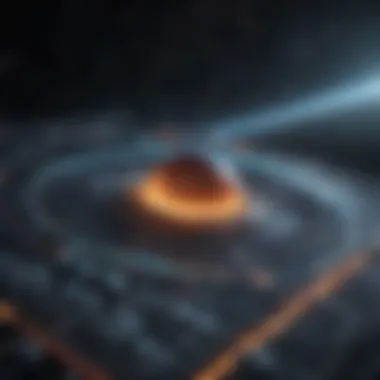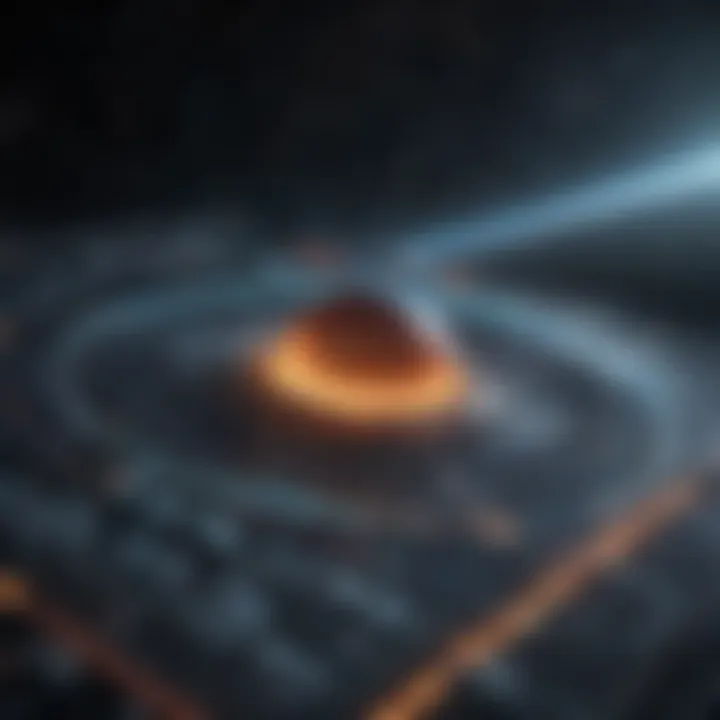Understanding Space Diagrams: A Comprehensive Exploration


Intro
Space diagrams are essential tools in various sciences and mathematics. They clarify complex relationships and phenomena by providing a visual representation. Understanding these diagrams can deepen comprehension for students and enhance problem-solving capabilities for educators and researchers alike.
The role of space diagrams has evolved over time, adapting to new discoveries and technological advancements. As education and research progress, the need for effective visualization continues to grow. This article aims to illuminate the key aspects of space diagrams, their construction, and their application across different fields.
Key Research Findings
Overview of Recent Discoveries
Recent studies emphasize the importance of space diagrams in several domains such as physics, engineering, and computer science. For instance, in physics, space diagrams help visualize forces acting on an object, making it easier to analyze motion and equilibrium. In computer science, algorithms and data structures can be better understood through diagrams that depict relationships and hierarchies.
Significance of Findings in the Field
These findings are significant because they illustrate how understanding spatial relationships can lead to better educational approaches. Researchers continue to explore how these diagrams can be adapted to various learning styles. Data from recent educational studies reveal that learners using space diagrams demonstrate improved retention of concepts compared to traditional methods.
"Understanding spatial relationships through diagrams enhances problem-solving skills and fosters a deeper grasp of complex concepts."
Breakdown of Complex Concepts
Simplification of Advanced Theories
Space diagrams act as a bridge between theoretical abstract concepts and tangible understanding. They break down intricate ideas into manageable visual segments that are easier to comprehend. For example, visual representations of multivariable functions allow students to see how changes in one variable affect others.
Visual Aids and Infographics
Effective visual aids are crucial for learning. Infographics play a vital role in simplifying advanced theories through the use of well-organized graphics and concise information. A well-structured space diagram can enhance clarity and allow for quicker assimilation of complex data.
Utilizing infographics and charts alongside space diagrams can enrich the learning experience by providing context and additional information. This strategy helps engage learners and facilitates better understanding across various topics.
The End
Prelude to Space Diagrams
Space diagrams play a crucial role in various fields of study, from mathematics to physics, as well as in computer science and life sciences. Understanding these diagrams provides readers with insights into complex relationships and data sets, making information more digestible. This article explores different aspects of space diagrams, highlighting their purpose and relevance across disciplines.
Definition and Purpose
Space diagrams are visual representations that map relationships within multi-dimensional spaces. They are designed to simplify complex information, allowing for easier analysis and interpretation. The primary purpose is to clarify relationships between variables, visualize data, and aid in problem-solving. Whether it is graphing functions in mathematics or representing forces in physics, space diagrams serve as effective tools for understanding intricate concepts and phenomena. They help in providing clarity to abstract ideas, making them comprehensible to a wider audience.
Historical Context
The development of space diagrams can be traced back to early mathematical discussions. Ancient Greek mathematicians utilized geometric representations to convey ideas. Over the centuries, as scientific inquiry evolved, the need for more sophisticated visual tools emerged. During the Renaissance, artists and scientists like Leonardo da Vinci began to explore perspective, establishing a visual language that would influence modern diagrammatic practices. This evolution continued with the advent of analytical geometry. Today, space diagrams are not confined to a single discipline; they have transformed into a versatile means of communication in research and education.
Importance in Scientific Communication
Space diagrams are essential in bridging gaps in understanding among various audiences. They elevate complex concepts to a level where a broader audience can engage with the material. For scholars, these diagrams allow for the presentation of data in a manner that emphasizes key aspects without overwhelming viewers. Moreover, in educational contexts, space diagrams foster discussion and stimulate curiosity. They enable students to visualize problems, enhancing their critical thinking and analytical skills. The integration of diagrams in scientific literature promotes clarity, reduces misinterpretation, and contributes significantly to knowledge dissemination.
"Visual representations are pivotal in facilitating comprehension, particularly in fields rooted in abstract concepts."
This exploration into space diagrams indicates their fundamental role across disciplines, making them not just a practical tool but a necessary one in academic and professional arenas.
The Elements of Space Diagrams
The construction and comprehension of space diagrams rely on specific elements that serve as the foundation for visual representation. Understanding these elements is crucial because they not only influence how information is presented but also how it is perceived and interpreted by viewers. Each element plays a significant role in enhancing clarity, facilitating problem-solving, and improving communication across diverse scientific fields.
Axes and Dimensions
Axes form the backbone of space diagrams, providing the necessary framework to visualize data. Typically, space diagrams consist of one or more axes, each representing a different variable. In mathematical contexts, these axes become essential when graphing functions. They help define the relationships between different variables and enable the visualization of trends and patterns.
For example, in a two-dimensional graph, the x-axis might represent time while the y-axis represents distance. This setup allows observers to easily grasp how distance changes over time. Understanding how to use axes requires meticulous attention to detail, as the scaling and labeling directly affect the interpretability of the diagram.
Data Representation
Data representation in space diagrams is vital for conveying complex information in a digestible format. This can include numerical data, categories, or varying sets of information. The purpose of proper data representation is to ensure that viewers can quickly understand the meaning behind the displayed information.
Choosing appropriate graphical elements—such as bars, lines, or shaded areas—can significantly impact how data is perceived. For example, line graphs are excellent for showing trends over time, whereas bar charts may better represent discrete data points. The clarity of the representation is essential. Effective legends, labels, and annotations provide additional context, ensuring that no vital information is lost.


Points, Lines, and Geometric Shapes
In the realm of space diagrams, points, lines, and geometric shapes are fundamental building blocks. Each of these elements conveys specific meanings and contributes to the overall portrayal of relationships within the data.
- Points: Often signify specific data values or coordinates in space. They serve as markers that pinpoint the intersection of variables.
- Lines: Represent relationships between variables. They help illustrate trends and make it easier to identify correlations. For example, a straight line can indicate a direct proportionality, while a curve may represent non-linear relationships.
- Geometric Shapes: Enclosed shapes provide clear visual groupings, indicating areas that may represent various thresholds or boundaries within the represented data.
A well-constructed space diagram employs these elements thoughtfully. The combination of points, lines, and shapes enhances comprehension and allows for a more nuanced understanding of the subject matter presented.
"The utility of space diagrams is heavily dependent on the elements that constitute them; clarity and precision are paramount."
By focusing on the elements of space diagrams—axes and dimensions, data representation, and geometric shapes—this section establishes a fundamental understanding necessary for effective visualization. Through this clarity, researchers and educators can foster deeper insights and facilitate learning in a variety of academic fields.
Applications of Space Diagrams in Mathematics
Space diagrams in mathematics serve as crucial tools for both understanding and visualization. Their applications extend beyond mere illustration; they facilitate complex concepts through clear representation. By employing space diagrams, mathematicians can effectively communicate ideas that might otherwise remain elusive in text-based formats. This section will explore two primary applications: graphing functions and vector representation.
Graphing Functions
Graphs are fundamental in mathematics and find their strength in their ability to visually represent relationships between variables. A space diagram provides an intuitive way to convey the values of functions, showing how changes in input affect output. For instance, plotting a quadratic function like y = ax^2 + bx + c helps make the concept of parabolas accessible.
When students interact with these diagrams, they can observe key features such as intercepts, vertices, and asymptotic behavior more easily. This dimensional insight can stimulate mathematical curiosity and allow for a deeper understanding of functions.
- Key Benefits:
- Visual representation of complex relationships
- Facilitation of problem-solving through graphical insights
- Immediate feedback on the behavior of functions
Despite their advantages, there are considerations to keep in mind when using diagrams. Ensuring clarity in the axes and careful scaling is vital. Misleading axes or distorted scales may convey incorrect information or obscure the intended message.
Vector Representation
Vectors are essential in mathematics, especially in fields like physics and engineering. Space diagrams vividly depict vectors, making it possible to illustrate their direction and magnitude in a clear and concise manner. For instance, in a two-dimensional diagram, one can represent vectors as arrows, with the length signifying magnitude and the arrowhead indicating direction.
Vector diagrams help in understanding various operations such as addition, subtraction, and the components of vectors. When learners visualize these points, they grasp ideas better. It also aids in transitioning from two-dimensional to three-dimensional spaces, which is a critical skill in many scientific applications.
- Considerations:
- Use consistent notation for clarity
- Always ensure vectors are represented to scale
"Space diagrams help bridge the gap between abstract mathematics and practical application."
Physics and Space Diagrams
Physics utilizes space diagrams to visualize complex relationships and behaviors of physical systems. These diagrams help in understanding abstract concepts by providing a visual representation of motion and force. Their application enhances learning for students and aids in the communication of ideas among researchers and educators.
Motion Analysis
Motion analysis through space diagrams allows for simplified representation of movement. For example, a position-time graph helps illustrate how an object moves through space over time. Instead of dealing with lengthy descriptions or complicated formulae, learners can see the relationship intuitively. This method is not just useful for students; it provides a framework for professionals analyzing real-world scenarios, such as the trajectory of a projectile. With various types of motion—uniform, accelerated, and circular—space diagrams clarify these concepts with distinct visuals.
Key elements of motion analysis include:
- Representation of Variables: Clearly showing time, distance, and velocity.
- Instantaneous vs. Average Values: Distinguishing between them through slopes in position-time graphs.
- Acceleration Representation: Using curves to indicate changing velocities, which can be essential in advanced physics.
By integrating these aspects, students can grasp complex ideas more swiftly and accurately.
Force Diagrams
Force diagrams play a crucial role in depicting the interactions between objects. Commonly known as free-body diagrams, these visuals outline the forces acting upon a single object. In physics education, force diagrams are fundamental for understanding Newton's laws of motion. Each arrow in a force diagram symbolizes a force's magnitude and direction, promoting a clearer understanding of equilibrium and dynamics.
One of the significant benefits of force diagrams is their ability to foster critical thinking. Students learn to analyze forces systematically, identifying factors like tension, gravity, and friction. By breaking down problems visually, they can solve complex equations more effectively.
"Force diagrams simplify the mechanistic view of physical processes and are key in the application of theoretical principles in real-life contexts."
Benefits of using force diagrams include:
- Enhanced Problem-Solving Skills: Visualizing forces aids in breaking down complicated scenarios.
- Precision in Calculations: Clear identification of all acting forces leads to more accurate predictions of outcomes.
- Facilitation of Group Work: They serve as a common language for discussing physics problems among peers or teams.
By embracing space diagrams in physics, educators can effectively enhance student engagement, comprehension, and analytical skills. Through these visual tools, the abstract becomes more tangible, bridging gaps in understanding for learners across various levels.


Computer Science Perspectives on Space Diagrams
In computer science, space diagrams play a crucial role in managing complex data structures and algorithms. These diagrams offer a visual representation, enabling developers to grasp intricate relationships and functionalities within their code. They assist in planning, debugging, and optimizing algorithms by providing a clear outline of how data flows and interacts within the system.
Data Structures
Data structures serve as the backbone of effective programming. Understanding how they work is vital for anyone involved in computer science. Space diagrams provide a method to illustrate these structures. For example, a binary tree can be displayed in a diagram, showing nodes, connections, and hierarchical relationships clearly. This visualization aids in comprehending data organization and retrieval methods. Key points include:
- Clarity: Diagrams simplify the understanding of complex relations between data elements.
- Debugging: They assist in identifying issues in data manipulation processes.
- Data Flow: Space diagrams present how data moves through different structures during execution.
Visual representation can turn abstract concepts into tangible ideas, making it easier for students and professionals to engage with the material.
Algorithm Visualization
Algorithm visualization is a powerful tool in computer science education and research. It offers insights into how algorithms operate, making abstract processes more understandable. Space diagrams can demonstrate algorithms step by step. For instance, visualizing a sorting algorithm can clearly show how elements are compared and arranged. Some benefits of using space diagrams in this context include:
- Comprehension: Students and developers can better understand algorithms when they visualize the process.
- Error Detection: When algorithms are mapped out, it becomes easier to spot logical errors or inefficiencies.
- Comparison: Diagrams allow for quick comparison between different algorithms, illustrating performance and complexity.
"Visual representation is not merely about aesthetics; it enhances understanding by bridging gaps in comprehension."
Life Sciences and Space Diagrams
Space diagrams hold significant relevance in life sciences, providing a structured means of visualizing complex biological systems and processes. A clear understanding of these visuals can lead to better insight into the dynamics between various organisms and their environments. Life sciences encompass diverse fields such as ecology, genetics, and physiology, all of which benefit from the analytical capabilities offered by space diagrams.
Ecological Models
In ecology, space diagrams serve as crucial tools for modeling ecosystems. They offer visual representations that make it easier to comprehend interactions among species, their habitats, and environmental factors. For instance, diagrams can illustrate food webs, showcasing the feeding relationships that sustain ecosystems.
"Ecological models using space diagrams can simplify the interpretation of inter-species relationships, aiding in the study of biodiversity."
These models can reveal how energy flows through an ecosystem, helping researchers identify key species and ecological functions. Moreover, by simplifying complex interactions, space diagrams promote effective communication among scientists and stakeholders, fostering collaboration in conservation efforts.
Genetic Mapping
Genetic mapping is another area where space diagrams prove crucial. By displaying the location of genes on chromosomes, these diagrams help researchers visualize genetic relationships and inheritance patterns. Genetic maps can show how traits are passed from one generation to another, facilitating the study of hereditary diseases, gene therapy, and the development of genetically modified organisms.
Using space diagrams in genetic studies allows for the mapping of traits by their markers, which can be represented distinctly along a chromosome. This visual approach aids in understanding genetic diversity and can enhance breeding strategies in agriculture.
Best Practices for Creating Space Diagrams
Creating effective space diagrams requires careful consideration of several factors. These diagrams serve to clarify complex information, making it accessible and comprehensible. A well-crafted space diagram stands out for its ability to present data visually while conveying essential relationships and concepts. Applying best practices enhances the utility of these diagrams, ensuring they meet the needs of a diverse audience, which may include students, researchers, and professionals.
Choosing the Right Types of Diagrams
Selecting the appropriate type of diagram is crucial for successful visualization. Various diagram types cater to different data representations and contexts. Here are some common types:
- Graphical Depictions: Ideal for functions or data trends, these diagrams allow for visual mapping of relationships.
- Flowcharts: Useful for illustrating processes or sequences, flowcharts guide the viewer through steps clearly.
- Scatter Plots: Effective in showing correlations between two variables, they help identify patterns in data.
- Network Diagrams: Leveraging nodes and connections, these diagrams illustrate relationships between distinct entities.
The choice of diagram influences clarity and the way information is processed. Depending on the purpose—whether it is to analyze data, explain concepts, or teach—this decision must align with the objectives of the presentation.
Clarity and Readability
Clarity and readability are paramount in conveying information effectively. A diagram can possess excellent data but may fail if users struggle to interpret it. To ensure clarity, consider these factors:
- Simplicity: Avoid unnecessary complexity. Stick to essential elements that convey the message without overwhelming the viewer.
- Labeling: Properly label axes, shapes, and connections. Clear labels guide the user to understand what each element represents.
- Visual Hierarchy: Use size, color, and placement to direct attention to key components. Important information should stand out without confusion.
- Consistent Style: Maintain a uniform style throughout the diagram to create a cohesive look. Fonts, colors, and symbols should be consistent.
"Effective diagrams do not only present data; they also communicate narratives through visual language."
By prioritizing clarity and readability, creators give their diagrams the best chance of achieving their intended impact. Consider user perspectives when composing diagrams, enabling an easy navigation through complex information.
Common Mistakes and Misinterpretations
Understanding space diagrams involves recognizing not just their value but also the common pitfalls that can distort their intended messages. In this section, we will explore some frequent errors that arise when creating or interpreting these diagrams. Acknowledging these mistakes is crucial for students, researchers, and educators, as it can save time and enhance clarity in communication. Avoiding misinterpretation ensures that the diagrams fulfill their purpose as tools for understanding rather than barriers to comprehension.
Overcomplicating Diagrams
One of the most prevalent errors in the creation of space diagrams is overcomplicating them. This mistake often arises from a desire to integrate too much information into a single diagram. While detail can enhance a diagram's utility, overwhelming the viewer with excessive data can lead to confusion rather than clarity.


To create effective diagrams, focus on the essence of the data being represented. For instance:
- Simplicity: Should be your guiding principle. Include only elements that support the primary message.
- Hierarchy: Use visual hierarchies to guide the viewer's focus. Important elements should stand out through size, color, or placement.
- Consistency: Maintain consistent notation and symbols. This helps the audience recognize patterns and relationships without cognitive overload.
When diagrams are straightforward, they convey information more efficiently. Thus, one should periodically reassess the complexity of a space diagram to ensure it communicates effectively without losing its core message.
Neglecting Context
Another significant misstep is neglecting context when interpreting or creating space diagrams. Each diagram should not just convey data, but also situate that data within a relevant framework. Without context, the viewer might misinterpret the relationships and findings presented.
Context can come from several facets:
- Background Information: Provide necessary background that explains why a diagram exists. This can include theories, previous research, or practical applications.
- Annotations: Use annotations to clarify unclear aspects. Labels or short descriptions can bridge gaps in understanding and ensure viewers grasp the content without assumptions.
- Target Audience: Recognize who will engage with the diagram. Tailor the complexity and depth of information to their knowledge level, ensuring it meets their needs.
Educational Implications of Space Diagrams
Space diagrams play a crucial role in education, particularly within scientific and mathematical contexts. They offer a structured way to visualize complex information. This enhances understanding and facilitates better learning. Moreover, these diagrams can bridge the gap between theory and practical application. When students engage with space diagrams, they can more effectively grasp the relationships and patterns within various subjects.
Enhancing Learning Outcomes
Using space diagrams in teaching can significantly improve learning outcomes for students. One reason is that these diagrams simplify the representation of data and concepts. For instance, in mathematics, space diagrams can visually depict functions, making it easier for students to interpret changes and trends. This visual aid fosters a deeper understanding of mathematical relationships.
Another critical aspect is that space diagrams can promote active learning. When students create their own diagrams, they engage with the material on a hands-on level. This not only reinforces their understanding but also helps in retention of information. Research consistently shows that the use of visual aids like space diagrams tends to improve overall academic performance. Additionally, these tools can facilitate collaborative learning environments, where students share and discuss their diagrams. This interaction allows for different perspectives and insights to emerge.
Supporting Diverse Learning Styles
Space diagrams cater to various learning styles, making them valuable educational tools. Visual learners particularly benefit, as they can grasp concepts more easily when presented in a visual format. However, the advantages extend beyond just visual learners. Kinesthetic learners, who learn by doing, can create their own diagrams that express their understanding.
Moreover, space diagrams can help auditory learners as well. Incorporating discussions about diagrams in classroom settings can enhance comprehension for those who excel in verbal processing. By using a multi-sensory approach through space diagrams, educators can support the diverse needs of their students effectively.
Furthermore, different disciplines can leverage space diagrams uniquely. In biology, for example, diagrams can illustrate complex processes like photosynthesis or cell division, enhancing both comprehension and recall. Similarly, in physics, space diagrams can clarify forces and movements, making abstract concepts more tangible. This cross-disciplinary application increases the relevance and effectiveness of space diagrams in diverse educational settings.
"Visual aids like space diagrams are not just supplementary tools; they are essential for effective learning across various disciplines."
By understanding and applying space diagrams, educators can significantly enhance the quality of instruction and learning experiences. This focus will likely result in better engagement and understanding of complex scientific and mathematical concepts among students.
Future Research Directions
In the realm of space diagrams, the future research directions offer a promising landscape of opportunities. These directions are essential for enhancing the applicability and understanding of space diagrams in various scientific disciplines. Exploring innovative strategies can lead to better teaching methods and improved analytical skills in students. There is a necessity to investigate new dimensions in visualization to convey complex concepts more effectively.
Innovative Visualization Techniques
Innovative visualization techniques are critical in pushing the boundaries of how space diagrams are presented and understood. Traditional approaches may not suffice for addressing complex data or intricate systems. Researchers must look into interactive models, which allow users to manipulate variables in real-time. This dynamic interaction can provide deeper insights, especially in fields such as physics and computer science.
- 3D Visualization: Three-dimensional diagrams can provide a richer context, enabling the visualization of data in various dimensions. The use of augmented reality (AR) and virtual reality (VR) could give learners an immersive experience.
- Algorithmic Art: Exploring generative algorithms could result in innovative visuals that adjust based on findings. This artistry can render data patterns more appealing and help to make connections between abstract concepts and concrete visuals.
- Machine Learning Integration: Employing machine learning models can assist in creating diagrams that learn from user interaction. The adaptation to user preferences enhances the educational experience and makes understanding intricate subjects more accessible.
Interdisciplinary Applications
Interdisciplinary applications of space diagrams represent a significant opportunity to enhance collaborative research. By bridging gaps between disciplines, space diagrams foster a better understanding of complex relationships that exist in nature and society.
- Engineering: In engineering, space diagrams can simplify the representation of forces and materials in structural analysis. Interdisciplinary collaborations could lead to more robust models that take into account environmental factors and human interaction.
- Social Sciences: Rarely discussed, but equally valuable, is the role of space diagrams in social sciences. They can help visualize social networks and relationships among diverse populations, thus enhancing research in sociology and psychology.
- Emerging Fields: In biotechnology or environmental science, the use of space diagrams can facilitate the understanding of ecosystem interactions and genetic variations. This would allow for a more holistic understanding of biological systems and conservation strategies.
These emerging research directions not only underscore the versatility of space diagrams but also highlight the potential for interdisciplinary collaboration to yield insights that might remain obscured in siloed disciplines.
Finale
The conclusion serves as a pivotal component in any comprehensive exploration of a subject. In this article, the conclusion solidifies the insights gained from the detailed examination of space diagrams. It emphasizes their vital role not just as tools for representation, but as bridges connecting various fields of study. Through clear and structured diagrams, complex relationships can be distilled into comprehensible formats, facilitating understanding across disciplines.
Recap of Key Points
A brief recap of the main points discussed in the article includes:
- Definition and Purpose: Space diagrams serve to illustrate and simplify complex concepts.
- Applications: They are widely used in mathematics, physics, computer science, and life sciences, showcasing their versatility.
- Best Practices: Emphasizing clarity and appropriateness in diagram creation enhances their functional value.
- Common Misinterpretations: Acknowledging potential mistakes can lead to better utilization of these diagrams.
- Educational Benefits: Space diagrams can improve learning outcomes and cater to various learning styles.
In summary, these elements collectively demonstrate the significance of space diagrams in conveying information effectively.
Final Thoughts on the Significance of Space Diagrams
Space diagrams stand as essential instruments in both educational and professional settings. They go beyond mere decoration in textbooks or classrooms; they are fundamental for communicating intricate ideas. Their significance is not limited to mathematics and science; they extend their reach into social sciences, engineering, and many other fields. As interdisciplinary connections grow stronger in the contemporary academic landscape, space diagrams emerge as a common language, making complex ideas accessible.
"Visual representation of data can transform understanding, often illuminating paths where words hit a dead end."
In an age where data and complexity are ever-increasing, mastering the use of space diagrams becomes increasingly vital for students, researchers, and professionals alike. Therefore, as academia continues to evolve, so too must our approaches to visualizing and interpreting information. Understanding these diagrams deeply enhances comprehension and fosters a collaborative atmosphere for knowledge sharing.















